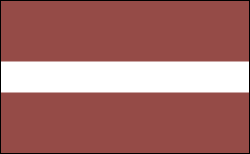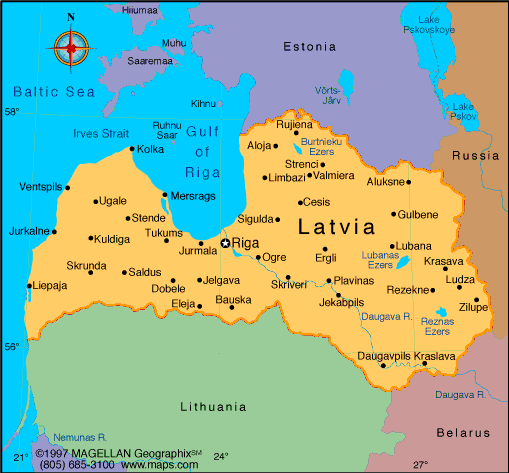LATVIA

Geography: Latvia borders Estonia in the north, Lithuania in the south, the Baltic Sea with the Gulf of Riga in the west, Russia in the east, and Belarus in the southeast. Latvia is largely a fertile lowland with numerous lakes and hills to the east.
Government: Parliamentary democracy.
History: Baltic tribespeople settled along the Baltic Sea and, lacking a centralized government, fell prey to more powerful peoples. In the 13th century, they were overcome by the Livonian Brothers of the Sword, a German order of knights whose mission was to conquer and Christianize the Baltic region. The land became part of the state of Livonia until 1561. Germans composed the ruling class of Livonia and Baltic tribes made up the peasantry. German was the official language of the region.
Poland conquered the territory in 1562 and occupied it until Sweden took over the land in 1629, ruling until 1721. The land then passed to Russia. From 1721 until 1918, the Latvians remained Russian subjects, although they preserved their language, customs, and folklore.
The Russian Revolution of 1917 gave Latvia the opportunity for freedom, and the Latvian republic was proclaimed on Nov. 18, 1918. The republic lasted little more than 20 years. Plagued by political instability, Latvia essentially became a dictatorship under President Karlis Ulmanis. The country was occupied by Russian troops in 1939 and incorporated into the Soviet Union in 1940. German armies occupied the nation from 1941 to 1944. Of the 70,000 Jews living in Latvia during World War II, 95% were massacred. In 1944, Russia again took control.
Government: Parliamentary democracy.
History: Baltic tribespeople settled along the Baltic Sea and, lacking a centralized government, fell prey to more powerful peoples. In the 13th century, they were overcome by the Livonian Brothers of the Sword, a German order of knights whose mission was to conquer and Christianize the Baltic region. The land became part of the state of Livonia until 1561. Germans composed the ruling class of Livonia and Baltic tribes made up the peasantry. German was the official language of the region.
Poland conquered the territory in 1562 and occupied it until Sweden took over the land in 1629, ruling until 1721. The land then passed to Russia. From 1721 until 1918, the Latvians remained Russian subjects, although they preserved their language, customs, and folklore.
The Russian Revolution of 1917 gave Latvia the opportunity for freedom, and the Latvian republic was proclaimed on Nov. 18, 1918. The republic lasted little more than 20 years. Plagued by political instability, Latvia essentially became a dictatorship under President Karlis Ulmanis. The country was occupied by Russian troops in 1939 and incorporated into the Soviet Union in 1940. German armies occupied the nation from 1941 to 1944. Of the 70,000 Jews living in Latvia during World War II, 95% were massacred. In 1944, Russia again took control.

Map of Latvia
President:
Raimonds Vejonis (2015)
Prime
Minister: Laimdota Straujuma (2014)
Land area: 24,903 sq mi (64,500 sq km);
total area: 24,938 sq mi (64,589 sq km)
Population (2014 est.): 2,165,165 (growth
rate: –0.62%); birth rate: 9.79/1000; infant mortality rate:
7.91/1000; life expectancy: 73.44
Capital and largest city (2011 est.):
Riga, 701,000
Monetary unit: euro
National
name: Latvijas Republika
Languages:
Latvian (official) 56.3%, Russian 33.8%, other 0.6% (includes Polish, Ukrainian, and Belarusian), unspecified 9.4% (2011)
Ethnicity/race:
Latvian 61.1%, Russian 26.2%, Belarusian 3.5%, Ukrainian 2.3%, Polish 2.2%, Lithuanian 1.3%, other 3.4% (2013)
Religions:
Lutheran 19.6%, Orthodox 15.3%, other Christian 1%, other 0.4%, unspecified 63.7% (2006)
National Holiday:
Independence Day, November 18
Literacy: 99.8% (2011 est.)
Economic summary: GDP/PPP (2013 est.):
$38.87 billion; per capita $19,100. Real growth rate: 4%.
Inflation: 0.2%. Unemployment: 9.8%. Arable
land: 17.96%. Agriculture: grain, sugar beets, potatoes,
vegetables; beef, pork, milk, eggs; fish. Labor force: 1.022
million; agriculture 8.8%, industry 24%, services 67.2% (2010 est.).
Industries: buses, vans, street and railroad cars; synthetic
fibers, agricultural machinery, fertilizers, washing machines, radios,
electronics, pharmaceuticals, processed foods, textiles;
note—dependent on imports for energy and raw materials.
Natural resources: peat, limestone, dolomite, amber,
hydropower, wood, arable land. Exports: $12.67 billion (2013 est.): wood and wood products, machinery and equipment, metals,
textiles, foodstuffs. Imports: $15.56 billion (2013
est.): machinery and equipment, chemicals, fuels, vehicles. Major
trading partners: Germany, Sweden, Lithuania, Estonia, Russia, Finland, Poland, Italy (2011).
Communications: Telephones: main lines in
use: 501,000 (2012); mobile cellular: 2.31 million (2012). Broadcast media:
several national and regional commercial TV stations are foreign-owned,
2 national TV stations are publicly-owned; system supplemented by
privately-owned regional and local TV stations; cable and satellite
multi-channel TV services with domestic and foreign broadcasts
available; publicly-owned broadcaster operates 4 radio networks with
dozens of stations throughout the country; dozens of private
broadcasters also operate radio stations (2007).
Internet Service Providers (ISPs): 359,604 (2012). Internet
users: 1.504 million (2009).
Transportation:
Railways: total: 2,239 km (2008). Highways: total: 72,440
km; paved: 14,707 km; unpaved: 57,733 km (2010). Waterways: 300
km perennially navigable. Ports and harbors: Riga,
Ventspils. Airports: 42 (2032).
International disputes:
Russia demands better Latvian treatment of ethnic Russians in Latvia;
boundary demarcated with Latvia and Lithuania; the Latvian parliament
has not ratified its 1998 maritime boundary treaty with Lithuania,
primarily due to concerns over oil exploration rights; as a member state
that forms part of the EU's external border, Latvia has implemented the
strict Schengen border rules with Russia.
-------------------- o --------------------
No comments:
Post a Comment